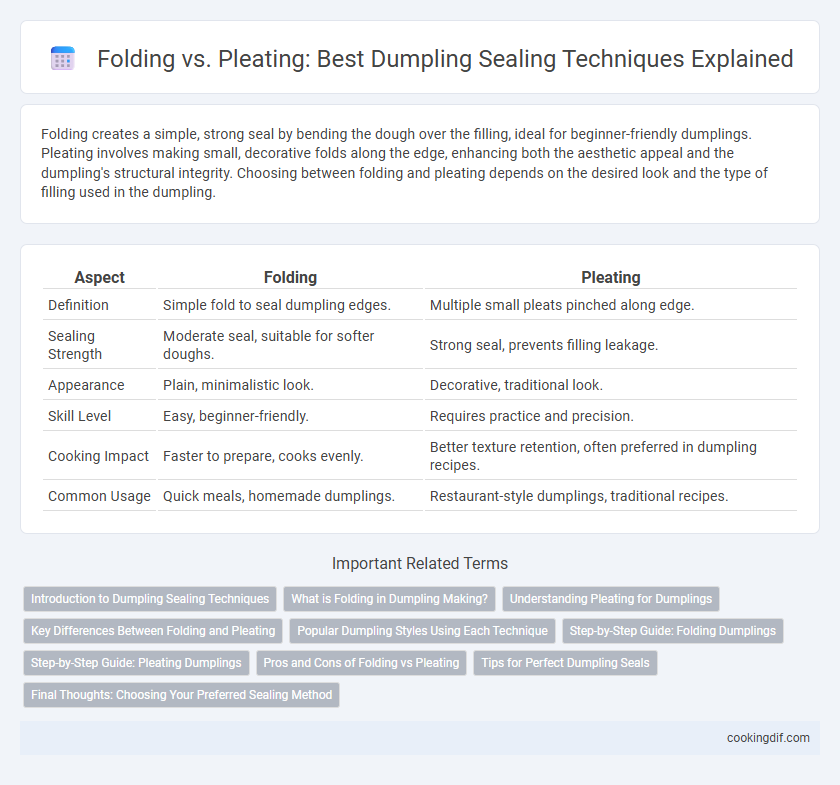Folding creates a simple, strong seal by bending the dough over the filling, ideal for beginner-friendly dumplings. Pleating involves making small, decorative folds along the edge, enhancing both the aesthetic appeal and the dumpling's structural integrity. Choosing between folding and pleating depends on the desired look and the type of filling used in the dumpling.
Table of Comparison
| Aspect | Folding | Pleating |
|---|---|---|
| Definition | Simple fold to seal dumpling edges. | Multiple small pleats pinched along edge. |
| Sealing Strength | Moderate seal, suitable for softer doughs. | Strong seal, prevents filling leakage. |
| Appearance | Plain, minimalistic look. | Decorative, traditional look. |
| Skill Level | Easy, beginner-friendly. | Requires practice and precision. |
| Cooking Impact | Faster to prepare, cooks evenly. | Better texture retention, often preferred in dumpling recipes. |
| Common Usage | Quick meals, homemade dumplings. | Restaurant-style dumplings, traditional recipes. |
Introduction to Dumpling Sealing Techniques
Folding and pleating are essential dumpling sealing techniques that ensure a secure, leak-proof seal while enhancing the dumpling's texture and appearance. Folding involves simple, straightforward methods like half-moon or triangle shapes, ideal for beginners seeking quick, reliable results. Pleating, characterized by intricate, repeated folds along the edge, creates decorative and airtight seals favored in traditional Asian dumplings such as Chinese jiaozi or Japanese gyoza, improving both functionality and visual appeal.
What is Folding in Dumpling Making?
Folding in dumpling making involves bending the dough over the filling to create a simple seal, typically by pressing the edges together with fingers. This technique ensures a tight closure, preventing the filling from leaking during cooking while maintaining a smooth surface. Folding emphasizes efficiency and simplicity, ideal for quick preparation without intricate designs.
Understanding Pleating for Dumplings
Pleating for dumplings involves creating a series of small folds along the dough edge, which enhances both the dumpling's structural integrity and visual appeal. This technique ensures a tighter seal compared to simple folding, preventing filling leakage during cooking while giving dumplings a traditional, decorative finish. Mastering pleating requires consistent fold size and pressure to maintain uniformity and effective cooking performance.
Key Differences Between Folding and Pleating
Folding involves creating a simple, clean edge by doubling the dough over itself to seal dumplings, resulting in a smooth, classic look. Pleating requires pinching the dough in small, repeated folds along the edge, producing a decorative, textured seal that enhances both appearance and structural integrity. The key difference lies in folding's straightforward technique versus pleating's intricate craftsmanship, affecting the dumpling's final presentation and durability during cooking.
Popular Dumpling Styles Using Each Technique
Folding is commonly used in Chinese dumplings like jiaozi and Japanese gyoza, creating a simple crescent shape that efficiently seals the filling while allowing it to steam evenly. Pleating, a more intricate sealing technique, is typically seen in soup dumplings such as xiao long bao and Korean mandu, providing a decorative edge and secure closure that prevents the rich broth from leaking. These techniques not only affect the dumpling's appearance but also influence cooking methods and texture, catering to diverse culinary traditions.
Step-by-Step Guide: Folding Dumplings
Folding dumplings involves carefully placing the filling in the center of the wrapper and then folding the wrapper in half to create a half-moon shape. Ensure the edges are aligned, then press firmly along the seam to seal the dumpling completely and prevent any leakage during cooking. The step-by-step folding technique emphasizes a smooth, tight seal without intricate pleats, ideal for beginners seeking a quick and effective dumpling preparation method.
Step-by-Step Guide: Pleating Dumplings
Pleating dumplings involves creating small, evenly spaced folds along the edge of the wrapper to securely seal the filling inside, enhancing both the texture and appearance. Begin by placing the filling in the center, moisten the edge with water, then pinch one side of the wrapper while folding small pleats toward the center, pressing firmly to seal each pleat. Proper pleating ensures dumplings remain intact during cooking and contributes to an appealing, traditional presentation.
Pros and Cons of Folding vs Pleating
Folding dumplings offers simplicity and speed, making it ideal for beginners and mass production, but it may result in less secure seals that risk leakage during cooking. Pleating provides a decorative, tight seal that enhances dumpling texture and presentation, though it requires more skill and time, potentially slowing down the preparation process. Choosing between folding and pleating depends on the desired balance between efficiency, aesthetics, and structural integrity.
Tips for Perfect Dumpling Seals
Folding dumplings involves overlapping the dough edges in a simple manner, creating a smooth seal ideal for thicker wrappers, while pleating forms multiple small folds that enhance both texture and strength, especially for thinner dough. To achieve perfect dumpling seals, ensure the dough edges are moistened lightly with water to improve adhesion, and avoid overfilling to prevent bursting during cooking. Using consistent pressure when pinching or pressing the edges together creates a tight seal that maintains the dumpling's shape and retains juices effectively.
Final Thoughts: Choosing Your Preferred Sealing Method
Folding and pleating are two essential techniques for sealing dumplings, each offering distinct textures and appearances that influence cooking results. Folding typically creates a smooth edge ideal for steaming, while pleating provides a decorative, crimped seal that enhances pan-frying durability. Selecting your preferred sealing method depends on desired texture, cooking style, and visual appeal suited to dumpling varieties like jiaozi or gyoza.
Folding vs Pleating for dumpling sealing techniques Infographic

 cookingdif.com
cookingdif.com